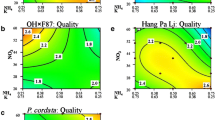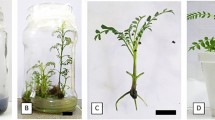Abstract
Ginger is an important perennial herb used for many purposes that has become a major spice crop across Ethiopia. Its production has been challenged primarily due to bacterial wilt disease eruption since 2012. The use of disease-free tissue culture generated seed rhizome as part of integrated management was considered as the best option to reduce this problem. However, attempts to produce large amounts of tissue culture plantlets were challenged by the lack of the major nitrogen source, ammonium nitrate. Hence, an experiment was designed to select potential alternative sources of nitrogen as a replacement of ammonium nitrate. The study evaluated three nitrogen salts at different levels in MS medium supplemented with 2.0 mg/l BAP and 1.0 mg/l Kinetin using ginger variety Boziab. A significant, highest mean shoot number was achieved with 1.0 g/l NH4Cl, followed by 3.8 g/l KNO3, and 3 g/l urea, with 9.33, 7.33 and 7.00 mean number of shoots, respectively. Shoot growth, rooting and survival after acclimatization were affected negatively at higher levels of NH4Cl. The highest mean number of roots (19) was observed on a medium containing 1.0 g/l NH4Cl, followed by control MS media (16). Survival after acclimatization was 98% for plants derived from medium containing 4.5 and 3.8 g/l urea and KNO3, respectively, and 95% for plants from medium containing 1.0 g/l NH4Cl. These findings indicate that low cost salts can be alternative potential sources of nitrogen to enhance large scale disease free ginger production in Ethiopia.
Key message
Ginger plantlets were successfully regenerated in ammonium nitrate replaced MS media. This is the first report on ginger using low-cost ammonium chloride and urea replacing ammonium nitrate as nitrogen source.



Similar content being viewed by others
Data availability
We declare that data of the experimental works at all stages and findings are available.
Abbreviations
- ANOVA:
-
Analysis of variance
- BAP:
-
6-Benzyl amino purine
- DAA:
-
Days after acclimatization
- LSD:
-
List significance difference
- MS:
-
Murashige and Skoog
- SAS:
-
Statistical analysis system
References
Asfaw K, Merga J, Genene G, Abukiya G (2021) Technical guideline for management of ginger bacterial wilt and leaf spot diseases in Ethiopia. Farm Africa. https://www.farmafrica.org/downloads/2022/
Atim M, Beed F, Tusiime G, Tripathi L, Asten P (2013) High potassium, calcium, and nitrogen application reduce susceptibility to banana Xanthomonas wilt caused by Xanthomonas campestris pv. Musacearum. Plant Dis 97:123–130
Ayenew B, Tefera W, Benti K (2012) In vitro propagation of Ethiopian ginger (Zingiber officinale Rosc.) cultivars: evaluation of explant types and hormone combination. Afr J Biotechnol 11:3911–3918. https://doi.org/10.5897/AJB10.1962
Bashar M, Hoque M, Siddique A, Syfullah K et al (2021) Potentiality of urea as a substitute for ammonium nitrate in tissue culture media for potato plantlets regeneration. Plant Cell Biotechnol Mol Biol 22:118–126
George EF, Hall MA, De Klerk GJ (2007) Plant propagation by tissue culture, vol 1, 3rd edn. Springer dordrecht, Netherlands
Geta E, Kifle A (2011) Production, processing and marketing of ginger in Southern Ethiopia. J Hortic For 3:207–213
Gezahegn G, Markos T, Million M (2019) Protocol adoption, in vitro regeneration of bacterial wilt free ginger (Zingiber officinale Rosc) plantlets and seed rhizome under protected conditions. Proc Agric Growth Progr Complet Crop Res 1:76–78
Hunduma T, Sodessa K, Getaneh G (2016) First report of ginger (Zingiber officinale) bacterial wilt disease in Ethiopia. Res J Agric For Sci 4(4):5–9
Hyndman, Hasegawa P, Bressan R (1982) The role of sucrose and nitrogen in adventitious root formation on cultured rose shoots. Plant Cell Tiss Organ Cult 1:229–238
Jansen PCM (1981) Spices, condiments and medicinal plants in Ethiopia: their taxonomy and agricultural significance. Centre for Agricultural Publishing and Documentation, Wageningen, The Netherlands. Serratia. J Gen Microbiol 98:39–66
Jean M, Cappadocia M (1991) In vitro tuberization in Dioscorea alata L. ‘Brazo fuerte’ and ‘Florido’ and D. abyssinica Hoch. Plant Cell Tiss Organ Cult 26:147–152. https://doi.org/10.1007/BF00039936
Kifle A, Belew D (2021) Leveraging early dry season planting of ginger under irrigation to enhance production from bacterial wilt infected seed rhizome. Afr Crop Sci J 29:259–275. https://doi.org/10.4314/acsj.v29i2.6
Mengs B (2018) In vitro diseases cleaning, micro-propagation and field establishment of ginger (Zingiber officinale Rosc.) Cultivars. Int J Pharm Sci Res 3:08–11
Murashige T, Skoog F (1962) A revised medium for rapid growth and bioassays with tobacco tissue cultures. Physiol Plant 15:219–223
SAS (2011) Statistical analysis software. Version 9.3. SAS Institute, Inc, USA
Tewolde S, Subban P, Zenebe T, Desta BS (2020) Assessing the efficacy of broad-spectrum antibiotics in controlling bacterial contamination in the in vitro micropropagation of ginger (Zingiber officinale Rosc). Sci World J. https://doi.org/10.1155/2020/6431301
Titus S, Wojtek D (2020) Business opportunity report spices sector in Ethiopia. ENTAG Nitherlands 1:22–23
Villamor CC (2010) Influence of media strength and sources of nitrogen on micro-propagation of ginger, Zingier officinale Rosc. E-Int Sci Res J 2:150–155
Zahid NA, Jaafar H, Hakiman M (2021) Micro-propagation of ginger (Zingiber officinale Roscoe) ‘Bentong’ and evaluation of its secondary metabolites and antioxidant activities compared with the conventionally propagated plant. Plants 10:1–17. https://doi.org/10.3390/agronomy11020320
Zakir et al (2018) Status of ginger (zingeber officinale) research and production challenges and future prospects in Ethiopia: a review. Acad Res J Agri Sci Res 6(5):276–290. https://doi.org/10.14662/ARJASR2018.027
Acknowledgements
This research was conducted with the funding from Southern Agricultural research institute and Addis Ababa University.
Funding
This research report was part of the first author’s PhD work and it was supported by budgets from the Southern Agricultural Research Institute and Addis Ababa University; Institute of Biotechnology. However, the authors declare that no funds or other supports were received during the preparation of this manuscript.
Author information
Authors and Affiliations
Contributions
All authors contributed to the planning and implementation of the work. Material preparation, data collection, analysis and first draft were performed by GG. Technical support, supervision and edition of previous versions were done by TF and YR. Hence, all authors read and approved the final manuscript for submission.
Corresponding author
Ethics declarations
Competing interest
The authors declare that they have no known competing financial interests or personal relationships that could have appeared to influence the work reported in this paper.
Additional information
Communicated by Amita Bhattacharya.
Publisher’s Note
Springer nature remains neutral with regard to jurisdictional claims in published maps and institutional affiliations.
Rights and permissions
Springer Nature or its licensor (e.g. a society or other partner) holds exclusive rights to this article under a publishing agreement with the author(s) or other rightsholder(s); author self-archiving of the accepted manuscript version of this article is solely governed by the terms of such publishing agreement and applicable law.
About this article
Cite this article
Gezahegn, G., Feyissa, T. & Rezene, Y. Replacement of ammonium nitrate by alternative nitrogen sources in MS medium to enhance ginger (Zingiber officinale Rosc.) in vitro regeneration. Plant Cell Tiss Organ Cult 154, 89–95 (2023). https://doi.org/10.1007/s11240-023-02513-7
Received:
Accepted:
Published:
Issue Date:
DOI: https://doi.org/10.1007/s11240-023-02513-7




